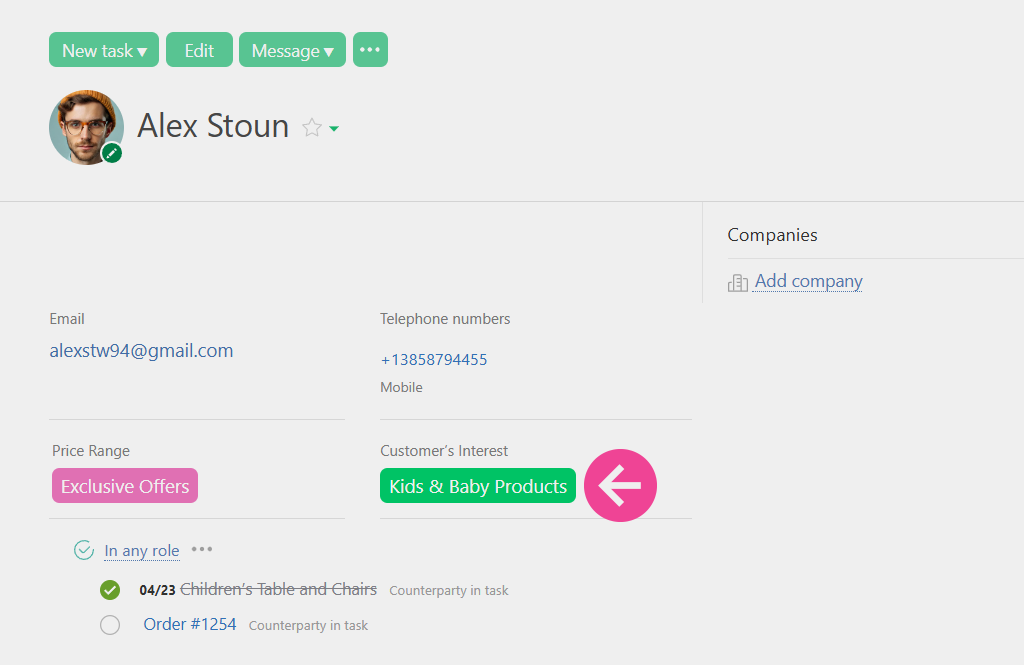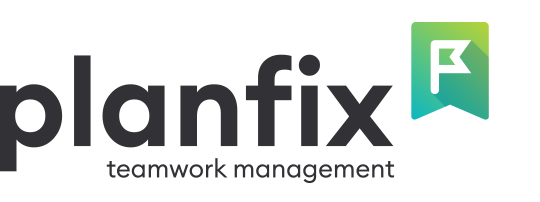
Grouping customers based on their preferences, buying habits, and behaviors is a great way for companies to fine-tune their marketing. That way, their campaigns feel more like a personal recommendation and less like spam. A reliable CRM system like Planfix plays a crucial role in this process by collecting and organizing segmentation data to help marketers work smarter, not harder. In this article, we will examine standard audience segmentation methods and demonstrate how Planfix can significantly simplify the process.
Customer Segmentation for Greater Efficiency
Customer segmentation means dividing your target group into various pre-determined categories. Think of it as sorting your closet: Business clothes in one section, casual clothes in another, and that weird costume you wore once but can’t throw away in another.
By segmenting their customer base, companies can gain valuable insights into their target audience. This ultimately makes personalizing products, promotions, and communications much easier. The result? Happier customers, stronger loyalty, and — most importantly — higher LTV.
Segmentation can be based on all sorts of different factors, including:
| Demographic | Geographic |
| Age Gender Income level Education Marital status Ethnicity | Country Region City Neighborhood |
| Psychographic | Behavioral |
| Core values Beliefs Interests Hobbies | Purchase frequency Types of products bought Website behavior Response to marketing campaigns |
Methods for Collecting Data
Collecting customer data can feel like detective work, but without the fabulous trench coat. And one of the biggest marketing challenges in customer segmentation is keeping that data current, relevant, and valuable. Here are a few tried-and-true methods:
- Surveys and questionnaires
- Website analytics tools
- Loyalty programs
The problem is that managing all this data manually is a one-way ticket to burnout. That’s where CRM systems come in. A CRM system provides a complete (and well-organized) picture of your customer base by centralizing customer interactions, purchase history, and transaction details.
Modern CRM systems have built-in data analysis tools and integrations for email marketing platforms and virtual telephony, or VoIP. These systems allow companies to track and target their audience more efficiently using laser-focused marketing efforts.
Successful Customer Segmentation Cases in Planfix
Now let’s take a look at how companies can improve their customer segmentation with Planfix CRM. Remember, Planfix is more than just a data collection tool — it transforms raw data into actionable insights, helping companies categorize their customers with pinpoint accuracy. That way, they can not only target them more effectively, but better retain them in the long term.
Dynamic Customer Segmentation
With its seamless integrations and powerful customization options, Planfix easily adapts to the unique needs of each business. This helps to ensure that customer interactions are more intuitive. Whether a company is trying to improve marketing efforts, streamline communications, or deliver highly personalized experiences, Planfix keeps them ahead of the game by engaging customers in the right way at the right time.
Learn more about dynamic segmentation in Planfix.
Tags Based on Interests
One of the easiest and most effective ways to segment customers is to categorize them according to what excites them: their product interests.
Instead of approaching all customers with the same strategy, Planfix allows companies to assign custom tags to each client, thus enabling more personalized communication and more relevant marketing. Planfix also makes it easy for managers to manually add these tags during interactions.

If adding tags by hand feels a little too tedious, you can also automate it. In this case, Planfix will automatically assign a tag based on the product category purchased when a deal is closed.
But these tags aren’t just for show — they help Planfix filter customer segments and seamlessly send contact details to specialized email marketing services. As a result, customers get targeted campaigns that land in the right inboxes, ensuring they are properly informed about products that interest them rather than random promotions.
For example, a customer who has just completed a full kitchen renovation probably won’t need to buy more kitchen cabinets anytime soon.
But what about a new parent who has just bought a stroller? They’ll probably need baby products for years to come.
RFM Analysis
RFM analysis is like a cheat code for understanding customer behavior. It segments customers based on three simple but meaningful metrics:
- Recency (R) – How often has the customer bought something recently?
- Frequency (F) – How often does the customer buy?
- Monetary (M) – How much do they usually spend?
To keep the data clear and easy to interpret, businesses can assign letter-based tags to each parameter:

For example, this system divides the customer base into 27 unique segments.
But Planfix goes one step further by automating the tracking of purchase frequency, transaction values, and recent purchase data. This means marketers don’t end up drowning in spreadsheets, allowing them to focus on developing more effective strategies.
For example, take a customer with an AAA rating who hasn’t bought for a long time and, when they do, spends very little. This customer is just passing through. Instead of putting resources into retention, companies can try to get them to return with a discount code or a special offer.

Now let’s say there’s a BCC customer who used to spend a lot of money and make frequent purchases, but has gone quiet in recent months. Losing him would be a big problem, so a simple discount wouldn’t work. Perhaps inviting them to join an exclusive loyalty program with special perks could rekindle their interest?

Instead of using a single blended index for all three factors, Planfix allows companies to track frequency, recency, and monetary value separately. This ends up providing much more flexibility when managing automated workflows.

Moreover, companies can create personalized marketing campaigns based on individual customer behaviors and preferences for each customer segment — an approach explored in detail in the article RFM Analysis in Planfix: How to Identify Your “Golden” Customers.
Reactivating “Sleeping” Customers
Every business has customers who use to make regular purchases but then mysteriously disappeared. It’s almost as if they were placed in some sort of witness protection program. Luckily, Planfix makes reactivating these B-segment customers effortless by automating emails with discount promo codes.
For example, if a formerly loyal customer hasn’t purchased in a month, Planfix can automatically send a message with a discount code to entice them back. Best of all, this message template can be easily updated to keep the offers current.
The best part? These reactivation messages are not just for email or SMS. If the “sleeping” customer has previously contacted you via WhatsApp or Telegram, Planfix can also send reminders via these platforms — provided they are integrated into the system.

Since every company has its own definition of ” sleeping,” Planfix allows every business to customize the criteria for their reactivation periods. Typically, marketers consider a customer “asleep” if they’ve missed an entire repurchase cycle, but with Planfix, it’s easy to customize this to meet your actual business needs.
Stages in the Buying Journey
Another proven way to segment customers is to track where they are in the buying process. Are they still weighing their options? Have they already made a purchase? Have they completely ignored you? Here’s a breakdown:
- In the decision-making process – Customers who are in negotiations and close to making a purchase.
- Uninterested – Those who either inquired by mistake (it happens) or ignore all follow-up questions.
- Lost leads – Seemed interested at first but then vanished into thin air.
- One-time buyers – They bought something once and never looked again.
- Returning customers – They occasionally come back and buy again.
- Repeat customers – Those who buy from you regularly (your MVPs)
Naturally, businesses want to win back lost leads and convert them into buyers. This can be done through intelligent, targeted email campaigns that directly address their hesitation:
- If price was the problem → Send a promo code with a discount.
- If the selection was too small → announce new products tailored to their interests.
A similar strategy can also be used to promote customer loyalty and encourage them to climb the engagement ladder. For example, you might announce seasonal sales to entice one-time shoppers to make a second purchase, turn casual shoppers into repeat customers with VIP benefits and loyalty rewards, or reward long-term customers with exclusive benefits like early access to sales or partner discounts.
Optimizing Marketing Strategies
Customer segmentation tools can also help companies analyze the best marketing platforms and refine their advertising strategies.
Planfix, for example, tracks and evaluates lead sources to identify where customers are most engaged.

Segmentation provides deeper insights by breaking down lead data by customer type. So, instead of seeing the overall numbers, companies can pinpoint which platforms attract high-value customers who make big purchases.
Smart Email Campaigns
One of the best ways to put customer segmentation analysis into action is through multi-stage email campaigns and marketing projects. A well-structured sequence can increase engagement and make your promotions more effective. Most importantly, it will come off as relevant and not “spammy.”
Here’s an example of a three-stage discount campaign:
- First email: Announcement of the promotion.
- Second email: Notification that the promotion has started.
- Last email: A final reminder before the offer ends.
Each message contains the same promotional code and is valid until a specific deadline. But what if a customer has already used the code after the first email?
Easy! With CRM tools like Planfix, you can automatically filter out customers who have redeemed the promotional code and remove them from subsequent emails.
This prevents unnecessary messages, keeps your emails relevant, and reduces the risk of your messages being marked as spam.
Summary
There are countless ways to segment customers, but the real challenge is choosing the right strategy for each situation. After all, marketing isn’t just about spreading advertising — it’s about delivering the right message to the right person at the right time.
With Planfix, companies can efficiently collect, analyze, and utilize customer data, making segmentation possible and effortless. And when segmentation is done right, it leads to higher engagement, better conversions, and a loyal customer base that keeps coming back.

